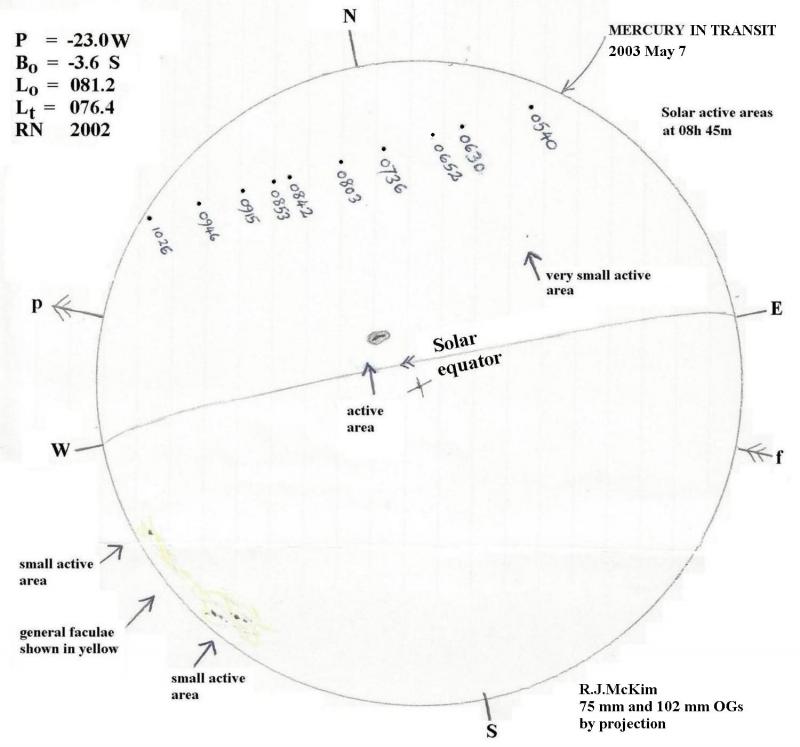2016 April 28
Some Historical Transits of Mercury

The first person to observe a transit of Mercury was the French astronomer Pierre Gassendi, in November 1631. Gassendi was able to use the newly published Rudolphine tables of Johannes Kepler, the first man to understand the elliptical nature of planetary orbits around the Sun. In the 1627 tables, which were dedicated to Kepler’s patron, Emperor Rudolph II of the Holy Roman Empire, Kepler made a number of predictions of upcoming events – in particular, a transit of Mercury in November 1631 and a transit of Venus in December of the same year.
Kepler died in 1630 without knowing if his predictions were accurate. Gassendi resolved to try to observe the Mercury transit. He projected the solar image onto a screen in a darkened room in Paris; on the floor above, an assistant was deputed to measure the altitude of the Sun in the sky. 1631 Nov 07 (date old style) was a cloudy day, but at 9 AM the Sun came out from the clouds, and Gassendi saw Mercury on the Sun. Gassendi stamped his foot to indicate that an altitude reading needed to be taken but his assistant, presumably doubting that anything would happen, had left the building! Gassendi had to watch the Sun disappear back behind the clouds, without a witness to his momentous discovery. Fortunately the assistant eventually returned and was able to corroborate Gassendi’s observation. Mercury was much smaller than he had expected, like a small perfectly circular sunspot – an indication that the size of the solar system was much larger than either Gassendi or Kepler had expected.
Gassendi also watched out for the 1631 transit of Venus, but failed because it turned out that it started after sunset in Western Europe. It fell to the Lancastrian astronomers, Jeremiah Horrocks and William Crabtree, to be the first to see a Venus transit, in December 1639. Another north-country astronomer, Jeremiah Shakerley, was the first Englishman to see a Mercury transit, from Surat, India, in 1651 October 24; perhaps the first telescopic astronomical observation from the Indian subcontinent. Shakerley was a protégé of the Towneley family from Lancashire, and after predicting the 1651 transit, decided to make his name by travelling to the Far East to observe it. He reported his successful observation in a 1653 letter to Henry Osborne, but little more was heard from him after this.
The first transit of Mercury observed from England was 1661 May 03, the coronation day of King Charles II. Among others, Christiaan Huygens observed the transit from London. Another well-known transit observer was Edmond Halley. Early in his career he sailed on an expedition to the South Atlantic. One of his tasks was to observe the transit of 1677 November 07 from the island of St Helena (this transit was also visible from England). On his return to England Halley published a paper in the Transactions of the Royal Society in which he explained how observations of transits, particularly of Venus, could be used to size the solar system. James Gregory had already suggested that observing transits from widely differing locations would allow the size of the astronomical unit to be computed in terms of a measurable distance on Earth’s surface. Halley’s observations of the Mercury transit allowed him to come up with workable methods of doing this, and led him to realise that Venus, being closer to the Earth, was more suited to the purpose.
A century later, Halley’s paper led to the dispatching of numerous expeditions around the world to observe the 1761 and 1769 transits of Venus. Among them was the expedition of Captain James Cook, with his astronomer Nathaniel Green, who are better known for mapping the coasts of New Zealand and Australia. In addition to observing the 1769 April 13 transit of Venus from Tahiti, on 1769 Nov 09 Cook and Green observed a transit of Mercury from the north Island of New Zealand, in a location now known as Mercury Bay.
I have personally only seen one transit of Mercury, in 2003. On May 9th this year, weather permitting, I will take time to spot this elusive planet as it crosses the Sun – shoulder to shoulder with Gassendi, Shakerley, Huygens, Halley, Cook and Green.
Please see https://www.britastro.org/node/7232 for more information and important advice on how to view this historic event in safety. Good luck and clear skies!
Mike Frost
Historical Section Director
| The British Astronomical Association supports amateur astronomers around the UK and the rest of the world. Find out more about the BAA or join us. |
